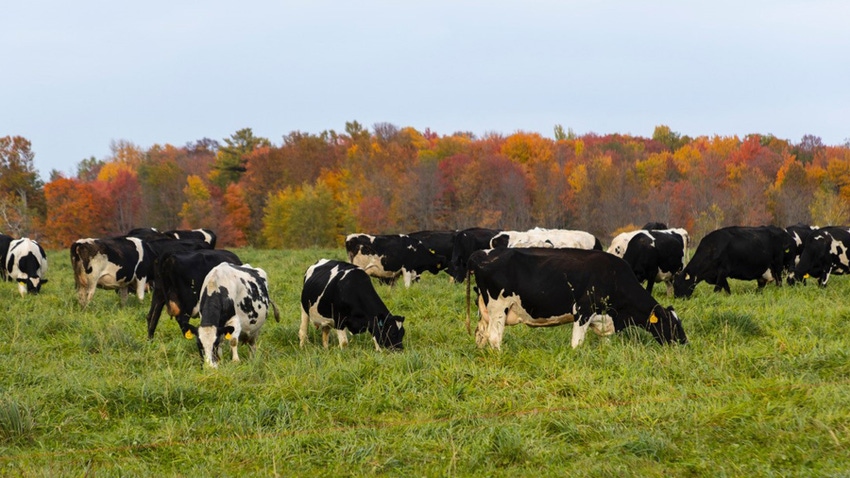January 9, 2024

by Aerica Bjurstrom
As we’ve started another new year, it’s a good time to reflect on what is essential for the farm. No doubt, profitability is a top priority. But what makes profitability possible?
Many farm owners and managers put cow comfort and herd health at the top of their list regarding farm management. Everyone knows that comfortable, healthy cows make more milk. Farmers who focus on herd health often have a regimen of maintenance practices such as hoof trimming and vaccination. They probably also have procedures for disease testing and removing animals from the herd that could pose a health risk to the rest of the herd. Most farms also have a list of diseases or issues they monitor so they can manage transmission and infection.
BLV infects dairy, beef cattle
One disease that may not get much attention on farms, but should, is bovine leukemia virus, which causes bovine leukosis. Sometimes referred to as cow HIV/AIDS, BLV compromises the immune system, which in turn enables the development of a variety of other diseases.
BLV infects dairy and beef cattle, and while an infected animal may not show clinical signs of the disease, it may have subclinical impacts for years. Cattle infected with BLV often suffer from reduced milk production, weight loss, shorter lifespan, impaired vaccine response and susceptibility to lymphoma. Lymphoma is a type of cancer affecting the lymphatic system. Nearly 27% of dairy cow condemnations in the U.S. are due to lymphoma. Dairy cow lymphoma is also the leading reason for condemnation in Canada.
According to Dr. Noriko Fukushi from the University of Tokyo, BLV integrates into host DNA as a provirus following infection and remains latent in cattle for life. There is no cure for BLV, but you can manage it. Prevention is the best management practice, but once a cow has it, reducing her ability to transmit to other cows should be a priority.
BLV is primarily transmitted through the transfer of infected blood cells between cattle. This can occur by using contaminated needles, surgical instruments, breeding or palpation sleeves, and dehorning equipment, among many other transmission paths. Transmission of BLV may also occur transplacentally from an infected dam to her fetus, or immediately postpartum when the newborn calf ingests BLV-infected colostrum produced by its dam. Results from a 2014 Japanese study demonstrated that the freezing treatment for colostrum provides a viable means of inactivating BLV-infected white blood cells in the milk.
While BLV is not typically transmitted through other body fluids, the risk of transmission through blood remains a significant concern for farmers.
BLV is costly
The economic impact of BLV can be significant on a dairy farm. According to a University of Calgary study, a significant reduction in 305-day milk, fat and protein yield was observed in BLV-positive cows when compared to BLV-negative cows. A Michigan State University study found that BLV-positive cows were estimated to lose between $198.34 and $496.76 per cow per lactation. Given these estimates, for an average dairy herd of 550 cows and 46% herd BLV prevalence, there would be an expected annual loss between $50,180 and $125,80 due to BLV infection.
The first step is knowing the prevalence in the herd, which can be done through ELISA or ELISA plus PCR testing. ELISA tests will identify positive, negative or suspect cows, whereas the ELISA plus PCR will tell you how severe the infection is in individual animals. Because PCR testing is somewhat more expensive, screening cows with ELISA and following up with PCR testing on only ELISA-positive cows is recommended. This approach will be more cost-effective and help determine which cows are shedding the disease and putting other cows at risk for infection.
Once cows are determined to be negative or positive, taking measures to control the spread of BLV is important. First, test all incoming and returning cattle. House separately and retest in 45 to 60 days. Manage cattle as if they were positive until BLV status can be determined.
If feasible, once in the lactating herd, manage positive and negative cows separately. Single-use needles should be used, or needleless application of medications is recommended. Use artificial insemination and a new OB sleeve for each cow. Do not feed colostrum from BLV-positive cows. Overcrowding (more than 110%) is also thought to contribute to BLV spread.
BLV affects almost all U.S. dairy herds and nearly half of U.S. dairy cows. Ultimately, managing BLV goes beyond animal health — it impacts farm profitability and consumer acceptance. Managing BLV requires testing, using consistent management protocols and removing super shedders from the herd. While over 20 counties have eliminated BLV from cattle, the disease won’t go away without diligent detection and management.
Bjurstrom is regional dairy educator for University of Wisconsin Extension in Kewaunee, Door and Brown counties.
You May Also Like




